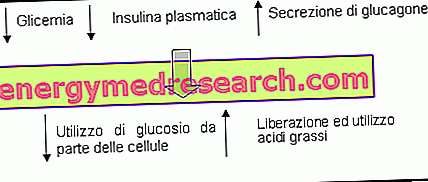Generality
The astrocytoma is a brain tumor that originates from particular glia cells, called astrocytes.
Astrocytomas may be benign or malignant and may have a different growth power.

Only thanks to an accurate diagnosis - through which the position and the gravity of the astrocytoma are outlined - is it possible to plan the most correct therapy.
In general, the most indicated treatment, which offers the greatest chance of recovery, is surgical removal.
Brief reference to brain tumors
When we talk about brain tumors, or brain tumors or brain neoplasms, we refer to benign or malignant masses of tumor cells that affect the brain (ie an area between the telencephalon, diencephalon, cerebellum and brainstem) or the spinal cord . Together, encephalon and spinal cord form the central nervous system ( CNS ).
Fruit of genetic mutations, of which however the precise cause is not known very often, brain tumors can:
- originate directly from a cell of the central nervous system (in this case we also speak of primary brain tumors );
- derive from a malignant tumor present in other sites of the body, such as the breast (in this second case they are also called secondary brain tumors ).
Given the extreme complexity of the central nervous system and the large number of different cells that compose it, there are many different types of brain tumors: according to the latest estimates, between 120 and 130.
Regardless of their malignant power or not, brain tumors are almost always removed and / or treated with radiotherapy and / or chemotherapy, as they often cause neurological problems incompatible with a normal life.
What is astrocytoma?
The astrocytoma is a brain tumor that originates from particular cells, called astrocytes .
Astrocytes are glia cells, therefore astrocytomas fall into the category of so-called gliomas, or brain tumors that derive from glia cellular units.
An astrocytoma can be benign or malignant in nature; furthermore, it can be focal or diffuse: focal astrocytomas appear as a mass of cells in its own right, quite distinct from the surrounding healthy brain tissue; diffuse astrocytomas, on the other hand, look like something "lost" in what surrounds them.

Difference between a benign tumor and a malignant tumor
A benign tumor is a mass of abnormal cells that grows slowly, has little infiltrative power and an equally poor (if not zero) metastasizing power.
Conversely, a malignant tumor is an abnormal cell mass that grows quickly, has high infiltrative power and almost always a high metastasizing power.
NB: due to infiltrative power, this refers to the ability to affect adjacent anatomical regions. With metastasizing power, on the other hand, reference is made to the ability of cancer cells to spread, through blood or lymphatic circulation, to other organs and tissues of the body (metastasis).
GLIA AND CELLS OF THE GLIA
With its cells, the glia provides support, stability and nourishment to the intricate network of neurons present within the human body and having the task of transmitting nerve signals.
In the central nervous system, the cellular elements of the glia are astrocytes, oligodendrocytes, ependymal cells and microglia cells.
In the peripheral nervous system ( SNP ), the cellular elements of the glia are Schwann cells and satellite cells.
LOCALIZATION OF ASTROCITOMES
Astrocytomas usually form at the level of the telencephalon, cerebellum and brainstem .
Only in rare situations do they arise from an astrocyte located in the spinal cord.
ASTROCYTOMA: FROM THE GRADE TO THE DIFFERENT TYPES
Brain tumors are divided into 4 degrees - identified with the first four Roman numerals - depending on their growth power.
Grade I and II brain tumors grow very slowly and involve a restricted brain area; generally they are benign.
In contrast, grade III and IV brain tumors expand with speed and invade the surrounding tissue regions; they are generally malignant.
A grade I or II brain tumor can, over time, turn into a grade III or IV tumor.
Based on the degree (or growth power) that characterizes them, astrocytomas are distinguished into:
- Pilocytic astrocytomas, which are degree I astrocytomas.
Characteristics : they are benign focal tumors, similar to cysts filled with liquid.
- Low-grade diffuse astrocytomas, which are Grade II astrocytomas.
Characteristics : they are common benign tumors.
- Anaplastic astrocytomas, which are Grade III astrocytomas.
Characteristics : highly malignant tumors, they are called anaplastic because the astrocytes of the tumor mass lose their typical appearance and take on the characteristics of undifferentiated cells (anaplasia process).
- Multiform glioblastomas, which are Grade IV astrocytomas.
Characteristics : they are highly malignant and possess a very high mortality. In the masses that constitute them, one can find blood vessels, deposits of calcium with cystic material.
Epidemiology
Astrocytomas are the most common gliomas (NB: gliomas are the most widespread brain tumors) and represent one third (therefore about 33%) of all primary brain neoplasms.
People of any age can develop an astrocytoma.
In children, grade I slow-growing astrocytomas are more frequent; in adults and the elderly, grade II astrocytomas and those with rapid growth (grade III and IV) are more common.
| Epidemiological data relating to the various types of existing astrocytomas | |
| Guy | Epidemiological characteristics |
Pilocytic astrocytoma | Pilocytic astrocytomas make up 2% of all astrocytomas. |
Low-grade diffuse astrocytoma | Low-grade diffuse astrocytomas account for 8% of all astrocytomas. Especially affecting people between 30 and 40 years. |
Anaplastic astrocytoma | Anaplastic astrocytomas make up 20% of all astrocytomas and mainly affect individuals between 30 and 50 years old, and the elderly. |
Glioblastoma multiforme | Multiformal glioblastomas make up 15-17% of all primary brain tumors and 54% of all gliomas. These are the most common malignant neoplasms of the brain and affect people aged 45 and over. |
Causes
Astrocytomas, as well as almost all human brain tumors, arise for reasons that are not yet known.
Symptoms and Complications
The symptoms of an astrocytoma can appear suddenly or very slowly, depending on the growth that characterizes the tumor mass.
In other words, if the astrocytoma is grade I or II, the pathological manifestations are gradually established; if instead the astrocytoma is grade III or IV, the problems related to it appear and evolve very quickly.
Although the site of tumor onset strongly affects the quality of the symptoms, there are some symptoms common to almost all forms of astrocytoma, namely:
- Headache;
- Nausea and vomiting, especially in the morning;
- Poor eyesight;
- Seizures.
These disorders are due to the increase in intracranial (or endocranial) pressure, which can occur for two reasons:
- Because the growing tumor mass prevents the cerebrospinal fluid from flowing normally.
- Because edema forms around the tumor mass.
AS THE SEAT OF THE TUMOR INCREASES THE SYMPTOMS
If astrocytoma resides at the level of the frontal lobe of the brain, patients tend to manifest:
- Sudden or gradual changes in mood and personality
- Weakness or numbness on either side of the body
If astrocytoma resides in the temporal lobe of the brain, the typical symptoms are:
- Coordination problems
- Language problems
- Memory alteration
Finally, if the astrocytoma resides at the level of the parietal lobe of the brain, the patients complain:
- Problems with writing
- Weakness or numbness in one of the two body sides
COMPLICATIONS
As far as malignant astrocytomas are concerned, the most serious complications consist in the expansion of the tumor mass - which invades the surrounding healthy tissues - and in the diffusion of neoplastic cells ( metastases ) into other organs of the body .
As for benign astrocytomas, a possible complication is their change to malignant tumors.
Diagnosis
Faced with a suspected case of astrocytoma, doctors begin their diagnostic investigations by careful physical examination and an analysis of the quality of tendon reflexes .

Finally, to dispel any doubts and to know the position and exact size of the tumor, they resort to specific tests such as:
- Nuclear magnetic resonance
- CT scan (or computerized axial tomography)
- Tumor biopsy
- Lumbar puncture
EXAMINATION OBJECTIVE AND TENDONS TRIMS, EYE TEST AND MENTAL-COGNITIVE EVALUATION
- The physical examination consists in the analysis of the symptoms and signs, reported or manifested by the patient. Although it does not provide any certain data, it can be very useful for understanding the type of pathology in place.
- The examination of tendon reflexes is a test that serves to assess the presence or absence of neuromuscular and coordinative disorders.
- Through an ocular test, the doctor observes the optic nerve and analyzes its involvement.
- The assessment of mental status and cognitive abilities is carried out with the intent to understand which area of the central nervous system may have developed a neoplasm. For example, finding memory disturbances would tend to suggest a neurological problem located in the temporal lobes, rather than in the parietal lobes and so on.
NUCLEAR MAGNETIC RESONANCE (RMN)
Nuclear magnetic resonance ( NMR ) is a painless diagnostic test that allows the visualization of the internal structures of the human body without the use of ionizing radiation (X-rays).
Its operating principle is quite complex and is based on the creation of magnetic fields, which emit signals capable of being transformed into images by a detector.
The magnetic resonance of the encephalon and the medulla provide a satisfactory view of these two compartments. However, in some cases, to improve the quality of the visualization, it could be necessary to inject a contrast liquid to venous level. In such situations, the test becomes minimally invasive, because the contrast liquid (or medium) could have side effects.
A classical nuclear magnetic resonance lasts about 30-40 minutes.
TAC
CT scan is a diagnostic procedure that uses ionizing radiation to create a highly detailed three-dimensional image of the internal organs of the body.
Although it is painless, it is considered invasive due to exposure to X-rays (NB: whose doses are by no means negligible compared to a normal radiograph). Furthermore, like MRI, it may require the use of a contrast agent - not without possible side effects - in order to improve the quality of the display.
A classic CT scan takes about 30-40 minutes.
BIOPSY
A tumor biopsy consists of the collection and histological analysis, in the laboratory, of a sample of cells from the neoplastic mass. It is the most suitable test if you want to go back to the exact nature (benign or malignant) and the severity of a tumor.
In the case of an astrocytoma, sampling usually takes place during a CT scan - this allows for a highly precise collection - and requires a small but delicate head surgery.
Treatment
The therapy to be adopted in case of astrocytoma depends on numerous factors, including the degree, position, size and growth rate of the tumor mass.
If the tumor resides in a position accessible to the surgeon's hands, the best thing to do would be to remove it . This applies both in the presence of a malignant neoplasm and in the presence of a benign neoplasm.
If astrocytoma is malignant and / or widespread, radiotherapy and, sometimes, chemotherapy should follow the surgical removal procedure.
| The treatments of an astrocytoma based on its degree (NB: it refers to a tumor located in a position accessible to the surgeon). | |
| degree | Treatment |
I (pilocytic astrocytoma) | Surgical removal is generally the only treatment adopted and sufficient to cure the tumor. |
II (low-grade diffuse astrocytoma) | Surgical removal is necessary and, if the diagnostic images show a considerable dispersion of the tumor mass, also radiotherapy. |
III (anaplastic astrocytoma) | Surgical excision and radiotherapy are essential. In some situations (for example relapses), chemotherapy could also become so. |
IV (glioblastomas multiforme) | |
Surgery
The ultimate goal of surgery is to remove all astrocytoma or, if that's impossible, most of the tumor mass.
The success of the removal depends on at least two factors, already called into question:
- The accessible or non-accessible position of the tumor mass . If the tumor is in an inaccessible position, it is impossible to remove it.
- The dispersion of the tumor mass in the remaining healthy brain mass . In this sense, Grade I astrocytomas, which are focal, are easily removable.
Since the surgery is somewhat delicate and dangerous, the doctor in charge, together with his staff, is obliged to inform the patient of the possible risks of the procedure before its execution.
RADIOTHERAPY
Tumor radiotherapy is a treatment method based on the use of high-energy ionizing radiation, with the aim of destroying neoplastic cells.
In the case of an astrocytoma, it is adopted in two very different situations:
- After and on completion of surgical interventions on grade II or higher astrocytomas.
- When the tumor is not surgically removable. In these situations, radiotherapy becomes the first and most important therapeutic treatment (NB: this also applies to cases of pilocytic astrocytoma).
CHEMOTHERAPY
Chemotherapy consists of the administration of drugs capable of killing all rapidly growing cells, including cancer ones.
In the case of an astrocytoma, doctors adopt it when they believe that the risk of a relapse (or relapse) is high or when they believe that the tumor has spread some of its cells in the rest of the body (metastasis). These situations are more likely when dealing with grade III or IV malignancies.
OTHER CURES
If astrocytoma causes edema around them, doctors may also plan corticosteroid-based therapy .
Corticosteroids are potent anti-inflammatories, ie drugs that reduce inflammation.
Main side effects of radiotherapy | Main side effects of chemotherapy | Major side effects of corticosteroids |
Fatigue itch Hair loss | Nausea He retched Hair loss Sense of fatigue Vulnerability to infections | Osteoporosis Obesity Indigestion Hypertension agitation Sleep disorders |
OPERATIONAL PHASE
After the surgical removal of the tumor and during radiotherapy and chemotherapy treatments, the patient must also follow a physiotherapy rehabilitation .
The aim of the latter is to recover, at least in part, the neurological faculties (coordination, language, etc.) that the presence of the tumor mass or the intervention itself have impaired.
Prognosis
The prognosis depends mainly on three factors:
- From the degree of astrocytoma . After removal of a grade I astrocytoma, those affected had a good chance of fully recovering. On the contrary, after the removal of glioblastomas, the people who were affected had an average life expectancy of just over 30 weeks.
- From the position of the neoplasm . The more the tumor is in an uncomfortable position for the surgeon, the more difficult it is to remove it. The lack of surgical removal of astrocytoma leads to a drastic reduction in the survival rate, as radiotherapy and chemotherapy are not as effective.
- Since the diagnosis took place . Later the tumor is detected, especially if malignant, the lower the chances of recovery. Astrocytoma removal itself is less effective.



